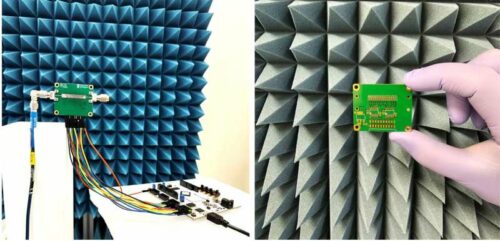The antenna sets the stage for 6G technology, offering speed, reliability, and new applications in communication and imaging.

The antenna’s capacity to function in the higher mmWave band positions it as a pivotal component in the emerging field of advanced beamforming metasurface antennas. This capability could be instrumental in enabling future 6G networks to provide ultra-fast data transfer and high reliability, ensuring superior service quality and seamless connectivity. Moreover, it opens up possibilities for innovative communication, sensing, and imaging applications, marking a significant advancement in network technology.
A research team from the University of Glasgow has created an innovative wireless communications antenna, leveraging the unique properties of metamaterials and advanced signal processing to achieve unprecedented performance levels.
Their Dynamic Metasurface Antenna (DMA) is the first in the world to be designed and demonstrated to operate at the 60 GHz mmWave band, which is internationally reserved for industrial, scientific, and medical (ISM) applications. The DMA’s high-frequency functionality is enabled by the use of specially designed metamaterials. These structures are meticulously engineered to enhance their interaction with electromagnetic waves, achieving effects that cannot be found in naturally occurring materials.
The DMA features fully tunable metamaterial elements meticulously engineered to manipulate electromagnetic waves via software control, establishing a sophisticated class of leaky-wave antennas capable of high-frequency reconfigurable operation. The compact, matchbook-sized prototype incorporates high-speed interconnects that allow simultaneous parallel control of individual metamaterial elements through FPGA programming. This enables the DMA to shape and create multiple communication beams simultaneously, with the capability to switch between them in nanoseconds, ensuring stable network coverage.
The DMA design offers multiple applications, such as patient monitoring by tracking vital signs and movements. It also enhances devices for high-resolution radar, aiding autonomous vehicles like self-driving cars and drones in safe navigation. Furthermore, its fast data transfer capabilities could revolutionize holographic imaging, enabling real-time projections of 3D models globally.
Reference: Abdul Jabbar et al, 60 GHz Programmable Dynamic Metasurface Antenna (DMA) for Next-Generation Communication, Sensing, and Imaging Applications: From Concept to Prototype, IEEE Open Journal of Antennas and Propagation (2024). DOI: 10.1109/OJAP.2024.3386452
The post Advanced Antenna Enhances 6G Technology appeared first on Electronics For You.
View more at https://www.electronicsforu.com/news/advanced-antenna-enhances-6g-technology.
Credit- EFY. Distributed by Department of EEE, ADBU: https://tinyurl.com/eee-adbu
Curated by Jesif Ahmed